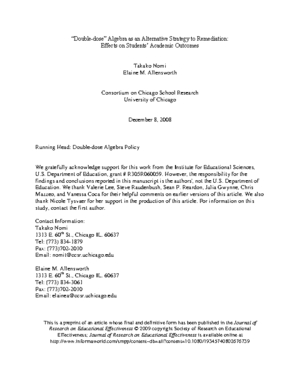1. Did putting lower performing students in double-dose algebra lead to significant improvement in their math achievement, measured by test scores, grades and pass rates?
2. Did the policy affect the academic outcomes of students who were not targeted by the policy (i.e., those entering high school with math scores above the national median)?
3. How did policy effects differ by students’ incoming math skills?
Expanded instructional time has become increasingly popular as a strategy to improve the academic outcomes of low-skilled students, particularly in ninth grade. We evaluate the efficacy of a double-period algebra policy initiated in the Chicago Public Schools in 2003. This policy required all students with eighth-grade test scores below the national median to enroll in a support algebra course in addition to regular algebra in ninth grade. We show the effects of the policy on students' grades, failure rates, and test scores in 9th-grade algebra and 10th grade geometry.
Providing support courses improved algebra test scores for the target population, but only modestly affected grades and failure rates. Students with very low initial abilities benefited less than students close to the national median. The policy also led schools to track algebra classes by students' entering math skills. As a result, it affected academic outcomes among students not targeted by the policy; test scores among high-ability students improved while their grades declined.
A working paper is a work in progress intended to contribute to current conversations in research, policy, and practice in a timely manner. The findings, interpretations, and conclusions expressed herein are preliminary thoughts solely of the author(s) and shared with permission of the author(s). These preliminary findings, interpretations, and conclusions may change upon further interrogation and collaboration with UChicago Consortium colleagues and other stakeholders in our work.
This paper was published in Journal of Research on Educational Effectiveness, April 2009, Volume 2, Issue 2, pages 111 - 148


